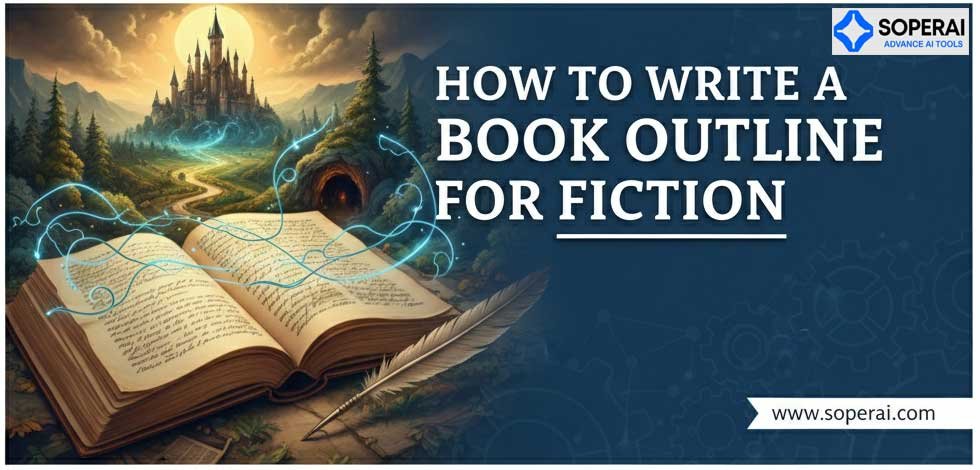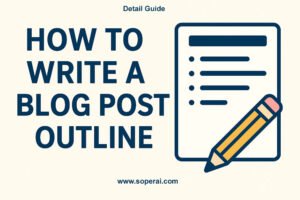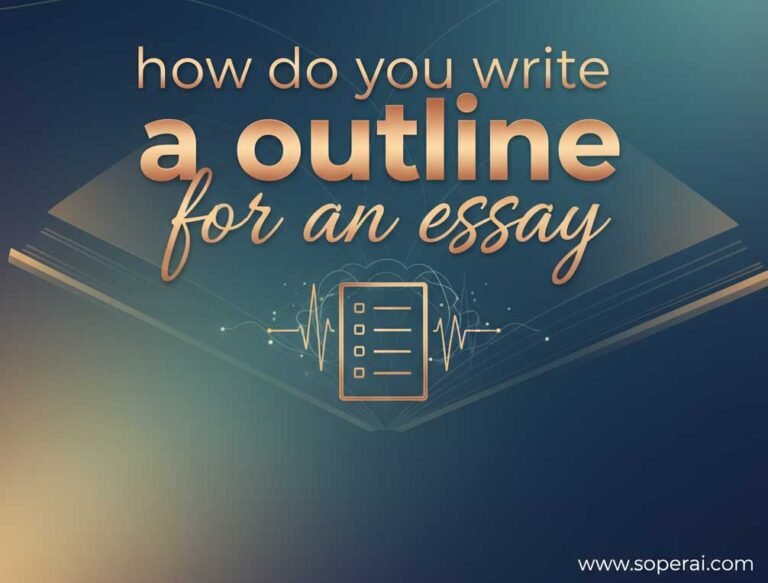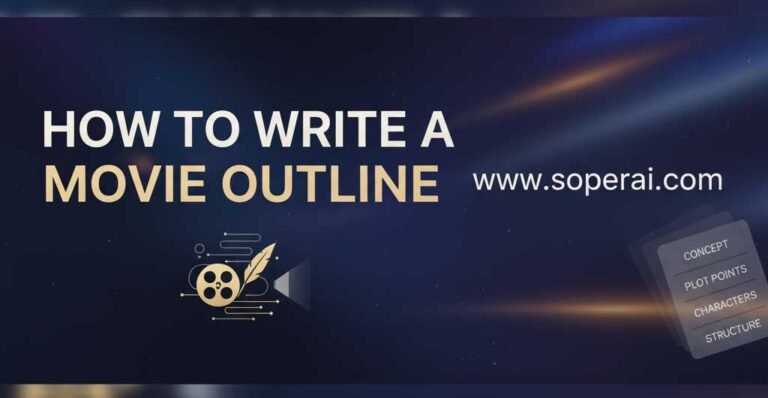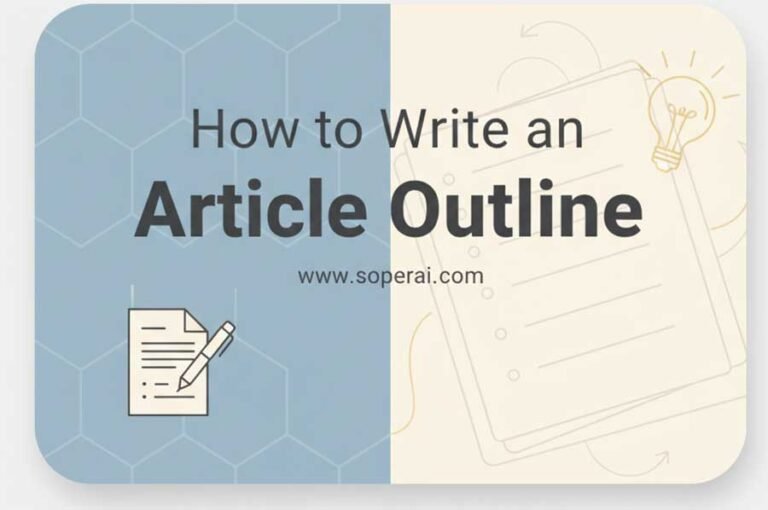The Complete Guide to Outlining Fiction
Transform Your Blank Page Into a Bestselling Story
I. Introduction
Picture this: You’re sitting at your desk, coffee growing cold beside you, cursor blinking mockingly on an empty page. You have a brilliant story idea—characters that feel real, a world that captivates you, conflicts that make your heart race. But when it comes to actually writing, you’re paralyzed. Where do you start? How do you turn that spark of inspiration into 80,000 coherent words?
You’re not alone in this struggle. The blank page dilemma haunts countless aspiring novelists, from first-time writers to published authors tackling their next project. The solution isn’t found in perfect prose or literary genius—it’s found in preparation. Specifically, in the art and science of fiction outlining.
A well-crafted outline serves as your North Star during the long journey of novel writing. It promises three transformative benefits: dramatically increased writing speed (imagine cutting your first draft time in half), superior plot coherence that keeps readers turning pages, and a significant reduction in the writer’s block that derails so many promising manuscripts.
Before we dive deeper, let’s acknowledge an important truth: writers exist on a spectrum. On one end are the “planners” (sometimes called “plotters”)—writers who thrive on detailed preparation and comprehensive outlines. On the other end are the “pantsers” (those who write “by the seat of their pants”)—writers who prefer to discover their story through the writing process itself. Most writers fall somewhere in between, and that’s perfectly fine. This guide offers techniques that can benefit everyone, regardless of where you land on this spectrum.
II. Why Outline Your Fiction?
Structural Benefits
Build a story architecture that stands the test of reader scrutiny
Practical Advantages
Write faster, revise less, and pitch with confidence
Creative Benefits
Experiment freely and strengthen your story before committing
Structural Benefits
Think of your favorite novel—the one you’ve read multiple times, where every plot point feels inevitable yet surprising. That seamless reading experience didn’t happen by accident. It’s the result of careful structural planning, whether done consciously through outlining or intuitively through extensive revision.
Maintains plot consistency and pacing: An outline serves as your story’s spine, ensuring that every scene serves a purpose and contributes to the overall narrative momentum. Without this framework, it’s easy to get lost in tangents or to rush through crucial plot points while lingering too long on less important scenes.
Prevents plot holes and continuity errors: We’ve all encountered that moment in a book where we pause and think, “Wait, didn’t the character say something completely different three chapters ago?” Or worse, “How did they suddenly know information they weren’t supposed to have?” These immersion-breaking errors are significantly reduced when you plan your story’s logical progression in advance.
Helps balance multiple storylines and character arcs: Modern fiction often weaves together several narrative threads—the main plot, subplots, character development arcs, romantic elements, and thematic explorations. An outline helps you orchestrate this complex symphony, ensuring no thread is forgotten and all elements reach satisfying conclusions.
Practical Advantages
Beyond the artistic benefits, outlining offers tangible, time-saving advantages that can make the difference between finishing your novel and abandoning it halfway through.
Reduces writing time and revision rounds: This might seem counterintuitive—spending time planning before you write. However, the hours invested in outlining typically pay dividends in reduced drafting time. When you know where your story is going, you can write with confidence and purpose, avoiding the meandering prose that requires heavy editing later.
- First draft completed in 3-6 months
- Major revisions focus on style and character depth
- Fewer structural overhauls needed
- Clear daily writing goals
- First draft may take 6-12+ months
- Extensive restructuring often required
- Higher likelihood of abandoning project
- Daily writing feels directionless
Provides roadmap during difficult writing days: Every writer faces days when the words won’t come, when motivation is low, or when the story feels broken beyond repair. An outline serves as a compass during these dark moments, reminding you of your destination and showing you the next step to take, even when inspiration fails.
Makes it easier to pitch to agents/publishers: Whether you’re querying agents or pitching publishers directly, you’ll need to summarize your story compellingly and completely. An outline makes this process infinitely easier, as you’ve already distilled your story to its essential elements. You can craft query letters, synopses, and elevator pitches with confidence, knowing exactly how your story unfolds.
Creative Benefits
Perhaps counterintuitively, constraints often enhance creativity rather than limit it. An outline provides structure within which your imagination can flourish more effectively.
Allows experimentation with story structure before committing: Want to try a non-linear narrative? Considering multiple POVs? Thinking about an unreliable narrator? Your outline is the perfect place to experiment with these techniques. You can test different structural approaches, rearrange scenes, and explore alternative plot developments without investing weeks in prose that might not work.
Helps identify weak plot points early: It’s much easier (and less emotionally devastating) to identify and fix plot problems in a 10-page outline than in a 300-page manuscript. Maybe your inciting incident isn’t strong enough, or your climax doesn’t feel earned, or your antagonist’s motivation is thin. These issues become apparent during the outlining process, when they’re still easy to address.
III. Different Types of Fiction Outlines
Just as writers come in different varieties, so do outlines. The key is finding the approach that matches your writing style, genre requirements, and project complexity. Let’s explore the main types, each with its own strengths and ideal use cases.
Brief Overview (1-2 pages)
The brief overview is outlining’s minimalist approach—a high-level story summary that captures the essential narrative arc without getting bogged down in details. Think of it as your story’s elevator pitch expanded to cover all major plot points.
- One paragraph setup
- Three-act summary (3-4 sentences each)
- Character motivation statements
- Theme identification
This approach works particularly well for experienced writers who have internalized story structure and can extrapolate details from high-level concepts. It’s also ideal for shorter works where excessive planning might feel like overkill. Literary fiction, which often focuses more on character development and theme than intricate plotting, frequently benefits from this lighter touch.
However, brief overviews can be treacherous for new writers or complex plots. Without sufficient detail, it’s easy to lose track of subplots, character arcs, or important foreshadowing elements. If you choose this approach, be prepared to develop your outline as you write, adding details as they become necessary.
Chapter-by-Chapter Outline
The chapter-by-chapter outline strikes a balance between high-level planning and granular detail. Each chapter gets its own summary, typically one to three paragraphs describing the key events, character developments, and plot progressions that occur.
- Brief chapter summaries (100-200 words)
- Key events and turning points
- Character emotional arcs
- Subplot progression tracking
This method excels for stories with multiple point-of-view characters, complex plots with several moving pieces, or genres that require careful world-building and consistent internal logic (fantasy, science fiction, mystery). It provides enough detail to maintain story coherence while leaving room for creative discovery during the writing process.
A typical chapter-by-chapter outline might look like this: “Chapter 12: Sarah discovers the hidden laboratory beneath the university library. She finds evidence of illegal experiments but is caught by Dr. Harrison, who reveals his connection to her missing brother. Meanwhile, Marcus’s investigation into the pharmaceutical company hits a dead end, but a chance encounter with a former employee provides new leads. The chapter ends with Sarah’s narrow escape and her realization that she can’t trust anyone.”
Scene-by-Scene Outline
The scene-by-scene outline represents the most detailed approach to story planning. Every scene—every individual unit of action that takes place in a specific time and location—gets its own entry in the outline.
- Individual scene descriptions (50-100 words)
- Goal/conflict/disaster for each scene
- Character emotional beats
- Specific dialogue or action notes
This method shines for new writers who benefit from detailed roadmaps, mysteries that require careful clue placement and red herrings, and any story where pacing and tension are crucial. It’s particularly valuable for thrillers, where every scene must serve the dual purpose of advancing plot and escalating tension.
The downside? Scene-by-scene outlines can become unwieldy for longer works, potentially stifling spontaneity and making the actual writing feel mechanical. Some writers also find that over-planning reduces their excitement about the story—they feel like they’ve already “told” it in the outline.
Character-Driven vs. Plot-Driven Approaches
Beyond the level of detail, outlines can be categorized by their primary focus: character development or plot events. Understanding this distinction helps you choose an approach that aligns with your story’s strengths and your genre’s expectations.
Structure: Organized around character growth milestones
Best for: Literary fiction, coming-of-age stories, psychological dramas
Structure: Organized around plot points and turning moments
Best for: Thrillers, mysteries, adventure stories, genre fiction
Character-driven outlines organize information around character development milestones. Instead of “Chapter 5: The heist begins,” you might have “Chapter 5: Marcus confronts his fear of failure and decides to trust his team.” The external events serve the internal character journey.
Plot-driven outlines, conversely, focus on external events and their logical progression. Character development still occurs but serves the plot rather than driving it. These outlines excel for genres where readers expect specific story beats and escalating external conflicts.
Most successful stories blend both approaches, but understanding your story’s primary driver helps you structure your outline effectively and meet your readers’ genre expectations.
IV. Essential Elements to Include
Regardless of your chosen outline style, certain foundational elements must be present to ensure your story’s success. Think of these as the load-bearing walls of your narrative structure—remove them, and the whole edifice collapses.
Story Foundation
Every compelling story rests on three pillars: conflict, stakes, and motivation. These elements work together to create the engine that drives your narrative from first page to last.
Central conflict and stakes: Your central conflict is the primary problem your protagonist must solve, while stakes answer the crucial question: “What happens if they fail?” The higher and more personal the stakes, the more invested readers become. Stakes can be external (saving the world, solving a murder) or internal (finding self-acceptance, overcoming trauma), but they must matter deeply to your protagonist.
Protagonist’s goal and motivation: Your protagonist must want something specific and important enough to drive them through obstacles and setbacks. But want alone isn’t enough—they need powerful motivation explaining why this goal matters. Goal without motivation feels arbitrary; motivation without a clear goal feels aimless.
Major plot points: Every story needs structural landmarks—the inciting incident that disrupts the protagonist’s normal world, the climax where everything comes to a head, and the resolution that shows how the conflict concludes. These aren’t arbitrary markers but organic moments that emerge from your character’s journey and your story’s logic.
Character Development
Characters are the heart of fiction. Readers connect with people, not plots, so your outline must account for how your characters grow and change throughout the story.
Character arcs and growth trajectories: A character arc is the internal journey your protagonist undergoes—how they change from beginning to end. This isn’t just about external circumstances but about internal growth, shifting beliefs, or evolving worldviews. Even in action-heavy genres, the most memorable stories feature characters who are fundamentally different by the story’s end.
- Clear starting emotional state
- Specific internal conflict or flaw
- Events that challenge their beliefs
- Measurable growth or change
- New equilibrium by story’s end
- Character unchanged from beginning
- Growth happens “off-screen”
- Change feels unearned or sudden
- No clear internal conflict
- External events don’t impact character
Key relationships and dynamics: Characters exist in relationship to others, and these dynamics create many of your story’s most compelling moments. Your outline should track how relationships evolve—allies who become enemies, mentors who disappoint, strangers who become family. These shifting dynamics often provide your story’s emotional core.
Internal and external conflicts: External conflict is what happens to your character (the dragon they must fight, the mystery they must solve), while internal conflict is what happens within them (the fear they must overcome, the prejudice they must abandon). The best stories weave these together so that resolving the external conflict requires growth in the internal realm.
World and Setting
Your story’s world is more than backdrop—it’s an active element that influences character behavior, creates opportunities and obstacles, and contributes to your story’s thematic meaning.
Important locations and their significance: Every significant location in your story should serve a purpose beyond mere scenery. Does the cramped apartment reflect your protagonist’s constrained circumstances? Does the abandoned warehouse create the perfect setting for a climactic confrontation? Your outline should identify these key locations and their narrative functions.
Rules of your fictional world: This is especially crucial for fantasy and science fiction, but every story has rules—how society works, what’s possible and impossible, what consequences actions have. These rules must remain consistent throughout your story, and your outline should establish them clearly.
Time period and cultural context: When and where your story takes place affects everything from dialogue and clothing to social expectations and available technology. Your outline should establish this context and consider how it influences your plot and characters.
V. Step-by-Step Outlining Process
Now that we understand the why and what of outlining, let’s explore the how. This five-step process provides a systematic approach to building your story’s blueprint, regardless of your chosen outline style.
Write a one-sentence story summary: This might seem simplistic, but distilling your story to its essence forces clarity. If you can’t summarize your story in one sentence, you may not understand it well enough to write it effectively. This sentence should include your protagonist, their goal, and the primary obstacle they face.
Examples of effective one-sentence summaries:
- “A young wizard must defeat a dark sorcerer to save his school and friends while discovering the truth about his parents’ death.”
- “A small-town lawyer must prove her client’s innocence while confronting corruption that reaches the highest levels of local government.”
- “An aging detective must solve one final case that forces him to confront the mistakes that destroyed his family.”
Identify your genre and target audience: Genre isn’t just a marketing category—it’s a contract with readers about what kind of story they’ll receive. Romance readers expect a satisfying romantic relationship; mystery readers expect a puzzle to solve; thriller readers expect escalating tension. Understanding your genre helps you include necessary elements and meet reader expectations.
Determine your story’s theme or message: Theme emerges from the intersection of character growth and plot resolution. What question does your story explore? What insight about life, relationships, or human nature does it offer? You don’t need to be heavy-handed about this, but knowing your theme helps ensure story coherence and emotional resonance.
Act I: Setup and inciting incident (approximately 25% of your story): Act One introduces your protagonist in their normal world, establishes the setting and supporting characters, and then disrupts everything with an inciting incident—the event that kicks your story into motion. This act should end with your protagonist committing to their journey, crossing a threshold from which there’s no easy return.
Act II: Rising action and complications (approximately 50% of your story): The longest act, where your protagonist faces escalating obstacles while pursuing their goal. This section often includes a midpoint—a major revelation or setback that changes the story’s direction. Act Two ends with the crisis or dark night of the soul—the moment when all seems lost and your protagonist must find the strength for one final push.
Act III: Climax and resolution (approximately 25% of your story): The final act contains your story’s climax—the decisive confrontation where your protagonist faces their greatest challenge. This is followed by falling action and resolution, showing how the conflict concludes and what the new normal looks like. The resolution should feel both surprising and inevitable, satisfying the promises made in your setup.
Protagonist and antagonist motivations: Your protagonist and antagonist should both want something desperately, and their goals should be mutually exclusive. The antagonist isn’t evil for evil’s sake—they’re the hero of their own story, with motivations they believe are justified. This creates richer conflict than simple good-versus-evil scenarios.
- Clear, understandable motivation
- Believes their actions are justified
- Poses genuine threat to protagonist
- Forces protagonist to grow
- Has their own character arc
- Evil without clear motivation
- Exists only to create obstacles
- Easily defeated or outsmarted
- One-dimensional personality
- No personal connection to protagonist
Supporting character roles and purposes: Every character in your story should serve a specific function. Some provide information, others create obstacles, still others offer emotional support or represent different worldviews. Your outline should clarify each character’s role and ensure they contribute meaningfully to your story’s development.
Turning points and revelations: Your story needs moments that change everything—revelations that recontextualize earlier events, decisions that cut off retreat, discoveries that force new understanding. These turning points create the sense of forward momentum that keeps readers engaged.
Conflict escalation moments: Conflict should intensify throughout your story, with each obstacle more challenging than the last. Your outline should map this escalation, ensuring that tensions build naturally toward your climax rather than remaining static or decreasing unexpectedly.
Character development beats: Character growth happens in specific moments—when beliefs are challenged, when fears must be faced, when relationships change. Your outline should identify these crucial beats and ensure they’re spaced throughout your story, not crammed into the ending.
Transition scenes and pacing: Not every scene can be a climactic confrontation or major revelation. You need quieter moments that allow characters (and readers) to process events, develop relationships, and prepare for upcoming challenges. These scenes are crucial for pacing and emotional resonance.
Subplots and secondary storylines: Subplots enrich your story by exploring themes from different angles, developing supporting characters, and providing variety in tone and focus. However, they must connect to your main story—either by complicating the central conflict, illuminating character growth, or reinforcing your themes.
VI. Popular Outlining Methods and Tools
Once you understand the principles of outlining, you need to choose tools and methods that suit your working style. Some writers think best with physical materials, others prefer digital solutions, and still others need visual representations to grasp their story’s structure.
Traditional Methods
Despite our digital age, many writers still prefer analog tools for their outlining process. There’s something about the physical act of writing, arranging, and rearranging that engages different parts of the brain and can spark unexpected insights.
Benefits:
- Easy to rearrange and experiment
- Visual overview of entire story
- Color-coding for different elements
- Tactile engagement with story structure
Index cards and cork boards: This classic method has been used by screenwriters and novelists for decades. Each scene gets its own card, which you can easily move, remove, or replace. Color-coding helps track different elements—blue for main plot, green for romance subplot, red for antagonist scenes. The visual overview helps you spot pacing problems, plot holes, or structural imbalances.
J.K. Rowling famously used a hand-drawn chart for outlining her Harry Potter books, with columns for each chapter and rows for different plot threads. This allowed her to track multiple storylines simultaneously and ensure each book’s various elements reached satisfying conclusions.
Notebook journaling: Some writers prefer the free-form nature of working in notebooks, where they can combine outline elements with character sketches, dialogue fragments, and thematic notes. This method works particularly well for discovery writers who want structure without feeling constrained by rigid formatting.
Benefits:
- Detailed tracking capabilities
- Easy to sort and filter information
- Word count and pacing calculations
- Multiple worksheets for different aspects
Spreadsheet organization: For detail-oriented writers, spreadsheets offer unparalleled organizational capabilities. You can create columns for chapter numbers, scene descriptions, POV characters, word count targets, plot thread tracking, character emotional arcs, and timeline management. Advanced users can even create formulas to calculate pacing, track word count goals, or identify chapters lacking certain elements.
Digital Tools
Modern technology offers sophisticated tools specifically designed for fiction writing, with features that would be impossible to replicate with analog methods.
- Cork board view mimics index cards
- Outline view with synopses
- Character and location sheets
- Research organization
- Split-screen editing
- Visual timeline creation
- Character arc tracking
- Multiple storyline management
- Template library
- Export to writing software
Scrivener’s outlining features: Scrivener revolutionized novel writing by combining word processing with project management. Its outlining features include a cork board view that mimics physical index cards, an outline view that shows hierarchical story structure, and the ability to write synopses for each scene or chapter. The software also integrates character sheets, location descriptions, and research materials, keeping everything accessible while you write.
Plottr and other dedicated software: Specialized plotting software like Plottr focuses exclusively on story planning. These tools excel at visualizing complex narratives with multiple timelines, character arcs, and interconnected plot threads. They often include templates for popular story structures (Hero’s Journey, Three-Act Structure, etc.) and can export outlines to various writing software.
Simple document outlines: Sometimes the simplest solution is the most effective. Many successful authors create their outlines in basic word processors, using heading styles to create hierarchical structures. This approach offers maximum flexibility with minimal learning curve, though it lacks the specialized features of dedicated software.
Visual Methods
Some writers are visual thinkers who need to see their story’s structure represented graphically. These methods can reveal connections and patterns that might not be apparent in text-based outlines.
Benefits:
- Non-linear organization
- Shows story connections
- Great for brainstorming
- Accommodates discovery writing
Benefits:
- Clear chronological order
- Visual pacing representation
- Easy to spot timeline issues
- Helpful for multiple POVs
Mind mapping: This non-linear approach places your central story concept at the center, with branches extending to major characters, themes, subplots, and key scenes. Sub-branches can explore character motivations, plot complications, or thematic elements. Mind mapping works particularly well during the brainstorming phase, helping you discover unexpected connections between story elements.
Story boards and timelines: Borrowed from film and animation, storyboards break your narrative into visual scenes. Even if you can’t draw, simple stick figures and rough sketches can help you visualize pacing, action sequences, and scene composition. Timelines work similarly but focus on chronological progression, making them invaluable for stories with complex time structures or multiple intersecting storylines.
Plot diagrams and charts: These include story mountains (showing rising and falling action), character relationship diagrams, and thematic exploration charts. Such visual representations can help you identify structural problems and ensure all story elements work together harmoniously.
VII. Common Outlining Mistakes to Avoid
Even with the best intentions, writers often fall into predictable traps that can undermine their outlining efforts. Recognizing these common mistakes helps you avoid them and create more effective story blueprints.
The over-outlining trap: When your outline becomes more detailed than your eventual novel, you’ve probably gone too far. Signs include knowing every piece of dialogue before writing, planning every character gesture, or feeling like you’ve already “told” the story in your outline. The solution isn’t to abandon planning but to find the right level of detail for your working style.
Remember that outlines should provide structure, not scripts. Leave room for characters to surprise you, for better dialogue to emerge during writing, and for subconscious creativity to contribute to your story. Many writers find that outlining major plot points while leaving scene-level details flexible strikes the right balance.
The under-outlining problem: If your outline consists of entries like “Chapter 12: Stuff happens” or “Sarah and Mark have conflict,” you haven’t provided enough direction for effective writing. Your outline should answer the basic questions: Who does what, where, when, and why? You don’t need every detail, but you need enough specifics to guide your daily writing sessions.
Outline inflexibility: Your outline is a tool, not a contract. When you discover a better plot twist, a more authentic character reaction, or a stronger thematic thread while writing, embrace it. Update your outline to reflect these improvements, but don’t abandon changes just because they weren’t part of your original plan.
The best outlines evolve with your story. Keep your original version for reference, but create updated versions as you write. This allows you to maintain the benefits of planning while remaining open to creative inspiration.
Character neglect: Even in plot-driven genres, character development drives reader engagement. Your outline should track not just what happens, but how events change your characters. Each major plot point should correspond to character growth or revelation. If your protagonist is the same person at the end as at the beginning, your plot probably isn’t affecting them deeply enough.
- Plot events emerge from character choices
- Characters grow through conflict
- Internal and external conflicts interweave
- Each scene serves both plot and character
- Character arcs reach satisfying conclusions
- Events happen TO characters
- Character reactions feel predetermined
- Growth happens off-screen or suddenly
- Characters serve plot rather than driving it
- Emotional beats feel forced or missing
Pacing problems: Good stories have rhythm—tension and release, action and reflection, conflict and resolution. Your outline should show this rhythm visually. If every chapter contains a major revelation or action sequence, readers will become exhausted. If too many consecutive chapters lack conflict or forward momentum, readers will become bored.
Consider using different colors or symbols in your outline to represent different scene types: red for high tension, blue for character development, green for world-building, etc. This visual representation can reveal pacing problems that aren’t obvious in text.
Genre blindness: Romance readers expect a satisfying romantic relationship, mystery readers want puzzles to solve, horror readers seek fear and tension. You can subvert these expectations creatively, but you should do so consciously, not accidentally. Your outline should account for genre requirements and ensure you’re delivering what your target readers seek.
VIII. Adapting Your Outline as You Write
The relationship between outlining and writing isn’t linear—it’s iterative. As you transform your outline into prose, new insights emerge, better ideas surface, and characters sometimes demand different paths than you originally planned. Learning to adapt your outline while maintaining story coherence is a crucial skill.
When and How to Deviate from Your Outline
Not all deviations from your outline are created equal. Some enhance your story, while others can derail it completely. Learning to distinguish between beneficial changes and problematic ones will save you time and improve your final manuscript.
Beneficial deviations often involve:
- Character authenticity: When a character’s reaction feels more genuine than what you originally planned
- Improved motivation: When you discover stronger reasons for character actions
- Enhanced conflict: When you find ways to raise stakes or create more compelling obstacles
- Better dialogue: When conversations develop more naturally than outlined
- Thematic depth: When you discover ways to explore your themes more effectively
Problematic deviations typically involve:
- Avoiding difficulty: Taking easier paths because the outlined scenes seem challenging to write
- Chasing shiny objects: Pursuing interesting but irrelevant tangents
- Character inconsistency: Making characters act against their established nature without justification
- Plot shortcuts: Rushing toward resolution without proper development
- Losing focus: Drifting away from your story’s central conflict or theme
Incorporating New Ideas That Emerge During Writing
Writing is a creative act that often generates unexpected insights. Your subconscious mind continues working on your story even when you’re not actively writing, sometimes producing better solutions than your conscious planning achieved.
Evaluate new ideas systematically: When inspiration strikes mid-scene, resist the urge to immediately rewrite everything. Instead, note the idea and continue with your current scene. Later, evaluate the new concept against your existing outline. Does it improve your story’s overall arc? Does it create more problems than it solves?
Test major changes in miniature: Before committing to significant plot alterations, try writing a brief summary of how the change would affect your entire story. This mini-outline helps you see consequences you might not have considered initially.
Consider ripple effects: Every change has consequences. If your protagonist makes a different choice in Chapter 5, how does that affect their relationships, the antagonist’s plans, and the story’s resolution? Your revised outline should account for these ripples to maintain story logic.
Maintaining Story Coherence While Allowing Creative Evolution
The challenge lies in remaining flexible without losing your story’s structural integrity. Your outline provides the skeleton, but the muscles, organs, and skin develop during writing.
Preserve your story’s core: Certain elements of your story are foundational—your protagonist’s primary goal, the central conflict, the thematic question you’re exploring. These can evolve and deepen, but fundamental changes risk creating an entirely different story. Before altering core elements, consider whether you’re improving your current story or starting a new one.
- Character motivations become clearer
- Conflicts deepen and become more personal
- Themes emerge more naturally
- Plot logic becomes stronger
- Story maintains original emotional core
- Story loses focus and direction
- Characters become inconsistent
- New subplots overwhelm main story
- Genre expectations are abandoned
- Original story becomes unrecognizable
Track cumulative changes: Small changes can accumulate into major story alterations without you realizing it. Periodically compare your current draft against your original outline to ensure you’re still telling the story you intended. If significant changes have occurred, create an updated outline that reflects your story’s current direction.
Updating Your Outline to Reflect Changes
Your outline should remain a useful reference throughout the writing process, which means updating it as your story evolves. This isn’t busywork—it’s practical story management that prevents continuity errors and helps you maintain narrative momentum.
Version control for outlines: Keep your original outline as a baseline, but create updated versions as you make significant changes. Date these versions and note the major alterations. This creates a record of your story’s evolution and provides fallback options if new directions don’t work.
Focus on functional updates: You don’t need to update every minor detail, but significant changes should be reflected in your outline. This includes character motivation shifts, plot sequence alterations, new subplots, or changed story outcomes. The goal is maintaining a reliable roadmap, not creating perfect documentation.
Use your updated outline for consistency checks: As you continue writing, refer to your updated outline to ensure new scenes align with recent changes. This is particularly important for complex stories with multiple storylines or when writing non-linearly.
IX. Conclusion
Your Journey from Blank Page to Bestseller
We began this guide with a writer facing a blank page, paralyzed by possibility and overwhelmed by the magnitude of creating a novel. Through our exploration of outlining techniques, methods, and principles, you now have the tools to transform that blank page into a compelling story blueprint.
Let’s recap the key benefits that await you: Increased writing speed that lets you complete your first draft in months rather than years. Better plot coherence that keeps readers engaged from first page to last. Reduced writer’s block because you always know what happens next. These aren’t just theoretical advantages—they’re practical improvements that can transform your writing experience.
The step-by-step process we’ve outlined provides a reliable path forward:
- Start with your story’s big picture and core concept
- Develop a three-act structure that supports your narrative
- Create character profiles that drive authentic conflict
- Plot major scenes that deliver emotional and plot payoffs
- Fill in transitional elements that create proper pacing
But remember—and this is crucial—outlines are tools, not rules. They serve your creativity, not the other way around. The perfect outlining method is the one that helps you tell your story most effectively, whether that’s a detailed scene-by-scene breakdown or a simple one-page overview.
Don’t be discouraged if your first attempt at outlining feels awkward or unnatural. Like any skill, it improves with practice. Start small, experiment with different approaches, and gradually develop methods that align with your creative process and story needs.
Your next step is simple: Choose one story idea you’ve been considering and create a basic outline using the principles we’ve discussed. Start with a one-sentence summary, develop it into a three-act structure, and then flesh out the key scenes and character arcs. Don’t aim for perfection—aim for completion.
The blank page that once intimidated you is now an opportunity—a space where your carefully planned story will unfold with confidence and clarity. Your outline is the bridge between the story in your imagination and the book in readers’ hands.
Begin today. Your story is waiting.
FAQS
1. What is a book outline in fiction writing?
A book outline is a structured plan that maps out the main plot, characters, and events of a story before writing the full manuscript.
2. Do I really need an outline to write fiction?
While some writers prefer “discovery writing,” an outline helps most authors stay organized, avoid plot holes, and write more efficiently.
3. What are the main elements of a fiction outline?
Typical elements include the story premise, main characters, setting, conflict, plot structure (beginning, middle, end), and key turning points.
4. How detailed should a fiction outline be?
It depends on your writing style. Some authors create a broad roadmap with chapter summaries, while others include scene-by-scene breakdowns.
5. What are the different types of book outlines for fiction?
Common methods include the Three-Act Structure, Hero’s Journey, Snowflake Method, and simple chapter outlines.
6. Can I change my outline while writing?
Yes! An outline is a flexible guide. Many writers adjust it as their characters and story evolve.
7. How long does it take to create a fiction book outline?
It can take anywhere from a few hours to several weeks, depending on the complexity of your story and the level of detail.
8. How do I outline characters in a fiction book?
Include details like their goals, motivations, conflicts, backstories, and how they grow or change throughout the story.
9. Is it possible to outline a series instead of just one book?
Absolutely. Outlining a series helps maintain consistency in plot and character arcs across multiple books.
10. What tools can I use to create a fiction book outline?
You can use simple tools like pen and paper, Word/Google Docs, spreadsheets, or specialized writing software such as Scrivener or Plottr.

